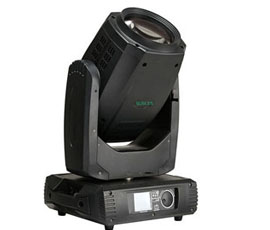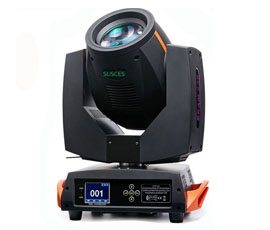
TV lighting and dance lighting design features
1 illumination requirements
The visual range of the human eye is relatively large, that is, the brightness range can be felt relatively large, whether it is sunny or moonlight dim, the human eye can be freely adjusted through the pupil to see the object, to distinguish the details. The stage lights watched by the human eye, the stage and the bright and dark brightness of the scene as long as the audience comfortable and comfortable on it.

The camera is adapted to adjust the brightness through the lens aperture and the internal CCD sensor sensitivity adjustment. When the studio illumination is low, the camera can open a large aperture, high illumination can open a small aperture. But the size of the aperture will affect the image of the effect and quality, such as the virtual reality of the virtual effect, image clarity and so on. When the camera aperture to the maximum, the halo will be more obvious; if the camera aperture is too small, because the diffraction phenomenon will reduce the image clarity. Therefore, as a TV lighting designer, be sure to keep the program recording the scene relative to the appropriate illumination, so that the camera can determine a suitable aperture opening to ensure the quality of the shooting screen. Neither the illumination is too small, forcing the camera to the maximum aperture; can not illuminate too much, forcing the camera to the minimum aperture, it will affect the effect of the TV screen. At the same time need to pay attention to different camera sensitivity is not the same, the requirements of the contrast is also different. Studio lighting is to ensure that the camera can be adjusted to the appropriate aperture, get a clear picture.
2 light ratio requirements
Light ratio refers to the light projection on the scene formed between the brightness and darkness between the brightness value of the scene using different light than modeling, can show different artistic effects, light than large, strong contrast, visual impact; Small, contrast soft, can make people feel a kind of soothing.
Stage lighting on the use of light than the rich, arbitrary, as long as the audience to meet the visual, freedom is very large. Many of the strong drama effect is to rely on the big dark big contrast to achieve (Figure 1). TV lighting is not the case, the camera allows the maximum contrast is limited. In the TV light cloth, the size of the illumination can be in a certain range by adjusting the cameras aperture to make up, but according to the object of light than the camera can not be adjusted, it should be said that the light is relatively objective, the camera is not Approach to the light according to the object from 2: 1 to 3: 1. If the light of the object is too large, beyond the allowable range of the camera, at this time, if the camera to illuminate the object as the standard adjustment of the aperture, so that the details of the light reflected, then the dark may be black paste into a ball; If the camera to adjust the aperture as a standard for the dark, then the dark can reflect the level, but the bright part may be exposed to white one. This is not ideal picture effect, are the director can not be used.

Designers of the scenery when the cloth is often through the surface light, slap in the face, side light, backlight, background light and other different light bits for light, according to the different requirements, different light bit size configuration, light requirements Not the same, but in general, the TV light requirements than the light can not be too large, if the light is too large, the camera reflects the screen or bright exposure, or dark side into a black paste. Lighting designers in the row row, rehearsal stage If you find the TV screen has this situation, to be timely to the light of the light by the adjustment. TV light task is to control the good scene of the illumination and light than through the camera to get a good view of the TV screen visual effects.
3 color requirements
The performance of the light art can also be achieved by changing the color of the light by changing the combination of the color of the light of the conventional lamp or the color wheel of the computer lamp to make use of the change of the color of the light, the effect of rendering the mood, or the red and green, gorgeous extravagant, or light red Green, warm and elegant.
For the stage lights, the use of color can be free bold, unfettered. As long as the program needs to meet, as long as the technical conditions can be achieved, as long as the audiences eyes can be accepted, what kind of color can be used. For the TV lights, the use of color should not be thick, different colors in the camera through the TV out of the color will be deepened, so the color used by the TV lights to be recorded on the monitor after the color effects To adjust. If the color of the TV light is configured according to the experience of the stage lighting, then many deep colors will be "paste" into one after the picture taken by the camera, and the details of the scene can not be reflected. Especially like blue, purple series and other cool colors, the human visual experience is obviously light blue, but after the camera after the TV screen is dark blue. If the experience of the stage lighting according to the color, the dark blue used in television lights, that appeared on the TV screen must be blue mess. So in terms of television lighting, in the use of color, not only to take into account the eyes of the audience, but also in close cooperation with the camera, grasp the degree of color, so that the color of the screen to the screen comfortable and transparent.
4 color temperature requirements
Color temperature is also a category of light color, this article will be listed separately, because the "color temperature" in the TV light is indeed a very important concept. The color temperature is the scale of the light color of the light source, in units of K (Kelvin). Color temperature is defined in accordance with the absolute black body, the color of the light source and the black body at a certain temperature issued by the same color, when the absolute temperature of the black body is called the color temperature of the light source. With the increase of color temperature, from the black body gradually to the "red - orange - yellow - blue" color transition

The same object in different color temperature light source will show different colors. For example, a piece of white paper, in the 3 000 K incandescent and 6 000 K fluorescent lamp irradiation, according to the truth of the color is not the same, the former is warm yellow, the latter is blue. But in fact, the human eye is not sensitive to this difference, no color knowledge of people often think that are white, which is the human eye "color vision conservation" phenomenon. The human eye of this adaptability, making people normal observation scene color, but can not accurately feel the color characteristics. It is because of this inertia of the human eye, in the stage lighting involved in the "color temperature" concept, do not do too much emphasis on the color of the light is mainly related to the human eye based on the vision.
But in the TV light, color temperature is a very important concept, which is mainly due to the camera for the external environment color changes are very sensitive, very "objective". Once the cameras white balance is determined, the light changes in the color temperature will be reflected in the TV screen, shooting bad TV picture in the face color is not restored, sometimes yellow or sometimes bluish, often is the TV light color temperature changes and the camera White balance is not a good reason for coordination.
Before the shooting, the TV lights and the camera coordination with a fixed workflow. First of all, the lighting workers to open a basic lighting source (referred to as the basic light source, the stage lighting is the main light source, generally refers to the performance of the surface light, slap in the face, backlight, etc.), the basic light source requires color temperature, and performance commonly used basis The same light source, the other performances will not be used when the different color temperature of the light off. Then, all the cameras of the different units are unified according to this basic light "whitening". "White" is often used by television workers a saying, the so-called "white" actually refers to the adjustment of a white balance of the short, that is, all the cameras first unified according to this base light source definition of a white, All the cameras have a common "white" standard. Different colors of light or color of light will be "white" as the basis for showing their different visual hue.
There is a very typical example of a television broadcast. In the purchase of follow-up light must be considered with the studio based light source or the main source color temperature matching problems. If the TV studios basic light source is 3 200 K low color temperature, chasing light is 6 000 K high color temperature, and the camera adjusts the white balance is based on 3 200 K basis light source, then the chisel lamp projection To the persons face, the color displayed on the TV screen will be significantly cold blue. On the contrary, the high color temperature of the basic light source must be equipped with high color temperature chasing light. If the studios base light source has a color temperature of 6 000 K and the chase is equipped with a 3 200 K light source, the camera will be projected onto the human face with the 6,000 K base light, After shooting the show is warm yellow, TV screen color cast must be very obvious, uncoordinated.
Therefore, the TV station in the purchase of chasing light is best to first consider their studio base light source color temperature, so that the light and studio base light color temperature consistent, in order to better restore the skin color. Of course, now chasing light can be equipped with warm color paper and light color paper, but after all, there may be inaccurate, color cast the case, if one step is not better? From the drama stage lighting design into the TV lighting design staff, often on the camera principle and some specific parameters did not reach the professional level of understanding, so many design procedures are still emotional, lack of rational judgment. As a TV lighting designer, the knowledge of the tutorial camera is very necessary, and this is also lacking the stage of the theater college stage lighting.
Excerpt from "Performing Arts" 2016 No. 4 Zhao Jianbo "on the TV lights and stage lighting differences








